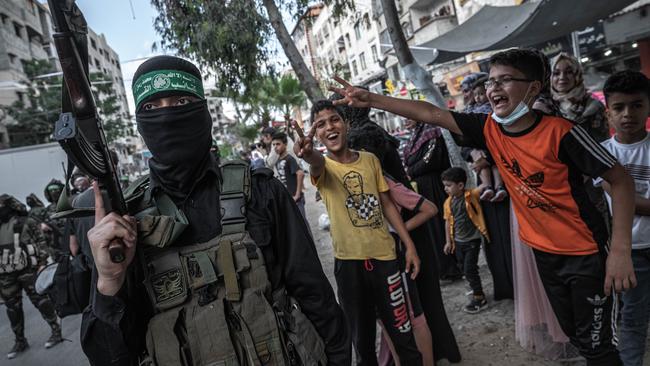
One local commercial TV news broadcast on Tuesday night referred to Israel as a 10 million-strong giant with a 600,000 military personnel (it did admit they are largely reservists) dominating tiny Gaza. That’s turning truth on its ear.
Israel, the only real democracy in the Middle East, faces not just Gazans, but 80 million Iranians who send those Gazans rockets, bombs and money. Israel sits a lonely Jewish island in a Middle Eastern sea of more than 400 million Muslims.
Iran and several Arab nations do not accept its right to exist. Schools in Gaza, controlled by the Hamas terrorist network, and even more moderate West Bank Palestinian schools, regularly preach the sort of violent hatred of Jews that would never be heard in a Jewish classroom discussing Palestinians, Muslims or Iranians.
Israel, while a dynamic economy, has GDP per capita of just over $US40,000 ($51,700), compared with Australia’s $US55,000. It’s not poor but it’s by no means the engine of world capitalism that many anti-Semites pretend.
The sheer task Israel faces trying to survive as a Jewish homeland is underscored by global numbers: 15 million Jews worldwide but 1.8 billion Muslims.
As editor in chief of The Australian I got Iran wrong late in my time at the newspaper. Having visited Gaza and seen Hamas up close, I thought president Barack Obama was right to try something different with his Iran peace initiative. I also felt Saudi sponsorship of Wahhabi Islamist terrorism was a bigger threat to the West at the time than Iran.
History proves president Donald Trump got the issue right. As The Australian’s foreign editor Greg Sheridan wrote last week, the latest violence from Hamas is in direct proportion to the ending of restrictions on Iran by President Joe Biden.
No one following the Middle East can be in any doubt the area was safer under Trump, as Muslim countries including United Arab Emirates, Bahrain and Sudan opened diplomatic relations with Israel. Fingers crossed, the Biden administration has learned a lesson and Friday’s ceasefire holds.
Yet journalists should not imagine relations between Jews and Palestinians in Israel are always poor. They can be at the edge of settler conflicts on the West Bank. But in greater Tel Aviv, a vibrant, largely secular city of 4.3 million people, they live in relative harmony. Same in most of Israel north of Tel Aviv, up to the Lebanon border.
The Australian media have largely swallowed a false narrative about the origins of the latest conflict, a localised property dispute in the Arab East Jerusalem neighbourhood of Sheikh Jarrah. The dispute, still before Israeli courts, has been portrayed as an attempt by Jews to settle an Arab neighbourhood. It’s been called “ethnic cleansing”. Nonsense.
It’s a rent dispute. The owners of the properties concerned are Jewish. They have proved title going back to 1875. The properties were occupied by Jordanian military forces in the 1950s after the invasion by five Arab armies including Egypt and Jordan, which refused to accept the UN declaration of the state of Israel in 1948.
The Arab tenants of the disputed properties have not paid rent since the 1990s. These properties are 75km from Gaza, an enclave that was part of Egypt until Israel again defeated invading Arab armies in the 1967 war.
This sort of multi-ethnic history is complex but the simple truth is in Tel Aviv, Jerusalem, and in cities such as Damascus and Baghdad, Jews lived peacefully for thousands of years before the rise of Shia and Sunni fundamentalism. Judaism is 4000 years old and Islam about 1400.
Israel was first hit by Palestinian suicide bombers, usually children on school buses, in the early 1990s. It’s a phenomenon no Jew can understand. After the Holocaust and the Munich Olympics massacre, Israel has brought enormous effort to protect the life of every citizen. Think of the Entebbe hijack rescue in 1976 or the decades of failed efforts to recover captured Israel Air Force weapons systems officer Ron Arad.
Yet the Palestinians too love their kids and want a better life for them. Speaking to the former PLO deputy Faisal Husseini at his house in East Jerusalem 30 years ago, I got a sense of how much more difficult this dispute is than, say, the Troubles in Northern Ireland or South African apartheid.
An urbane, well educated man, Husseini said: “I understand the Jews think they are the chosen race and this is their promised land. The problem is I also know this city is always the province of the Mufti of Jerusalem.”
On the same trip former ABC World Today host Richard Palfreyman and I were lucky enough to meet Israeli PM Yitzhak Rabin, later gunned down by a fundamentalist Jew.
Rabin, a two-time prime minister, led the tanks charging Syrian forces up the Golan Heights in 1967.
A veteran of the original battle for Jerusalem before independence, he had persuaded settlers on the Golan to accept his Labor government’s land for peace and the two-state solution with Yasser Arafat in the 1993 Oslo Accord.
Arafat, despite jointly accepting the Nobel Peace Prize with Rabin, could not do the deal. Several attempts by Rabin’s successors also failed.
Think about this: in what other country could a social democrat prime minister persuade rural settlers at a general election to vote to give up their own homes to their enemies in a bid for peace?
Israel has since learned to live with the idea its neighbours want to drive it into the sea. Not unreasonably it will do whatever it takes when subjected to attacks on civilian targets such as the 3000 rockets fired by Hamas over the past fortnight.
Journalists talking about the proportionality of Israel’s strikes in Gaza really need to ask themselves if the rocket fire on civilian Israelis is a proportionate response to an obscure property dispute.
Israel will weather the public relations storm as it has done since the first intifada from 1987-93. Sky News host Andrew Bolt last week criticised journalists for allowing themselves to be manipulated by sad pictures of child victims of Israeli bombing. He is right when he says this is a longstanding Hamas tactic.
Many journalists, including the local union the Media, Entertainment and Arts Alliance, are furious Israel last week bombed a building housing reporters from Al Jazeera and AP. Colonel Daniel Reisner, for 19 years the chief legal adviser to the Israeli Defence Forces Military Advocate General’s Corps, told me on Thursday there was strong intelligence the building housed senior Hamas figures.
Everyone in the building was warned in advance of the action. He said the IDF had a clear policy of proportionality under international military law: “The concept in law does not however mean if Hamas fires two bullets Israel can only fire two bullets.”
Asked why AP and Al Jazeera would want to have offices in Gaza, Reisner said: “I understand why journalists want to be on the ground. But news consumers need to understand all footage and reporting coming from Gaza is carefully controlled by Hamas. Reporters and photographers are showing only what they are permitted to show.”
Reisner said Hamas military tactical documents captured 10 years ago made clear the group had a deliberate policy of ensuring children were always near potential targets, so as to maximise the propaganda value in the West of any casualties.




In an age when journalists think advocating for the weak rather than reporting the truth is their real job, it’s no wonder few report the facts about violence in Israel and Gaza.